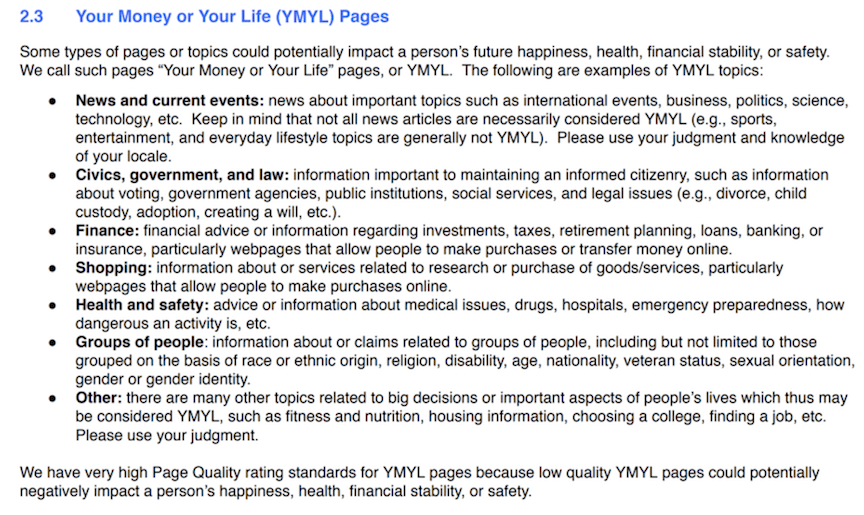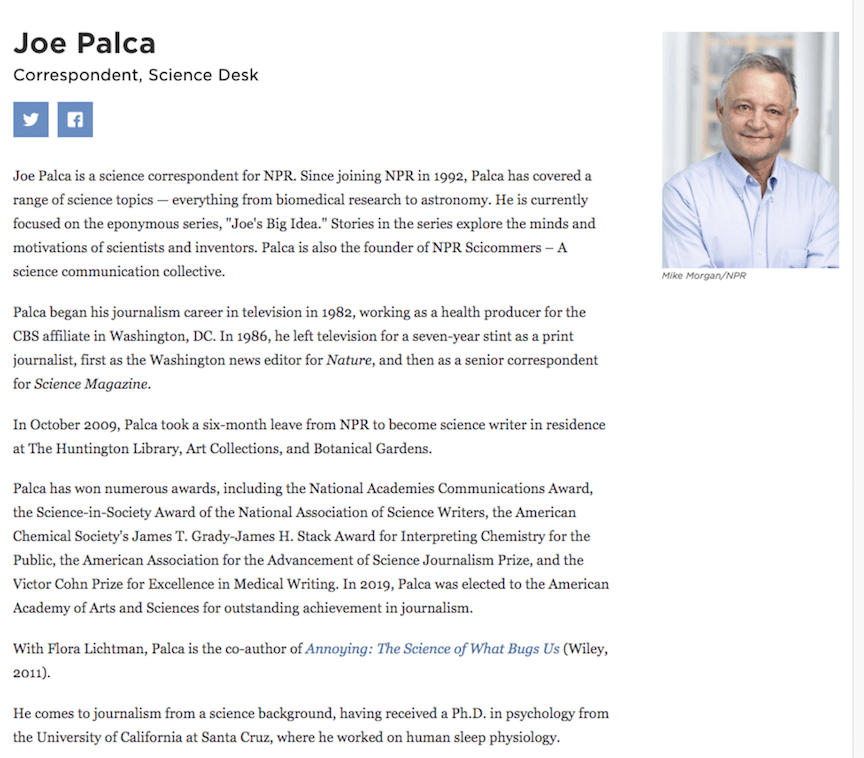-
 9 min. read
9 min. read
-
 Sarah Berry
Sarah Berry Lead Web Marketing Consultant
Lead Web Marketing Consultant
- Sarah Berry is a Lead Web Marketing Consultant at WebFX. With more than 10,000 hours of experience, she offers practical insights and strategies you can use to grow your digital revenue. When she isn’t polishing her Time Magazine Person of the Year Award, she’s spending time with her flock of ducks.
If you’ve been learning about search engine optimization (SEO) on various SEO content sites, you may have heard the acronym E-A-T floating around. If you’ve heard of E-A-T SEO, you’re probably wondering what it is (hint: it has nothing to do with food) and how it can improve your SEO. That’s exactly what you’ll find out in this article!
At WebFX, we have more than 29 years of experience and a team of more than 500 digital marketing experts focused on getting results for our clients. Contact us to learn more about our digital marketing services. Learn how we increased traffic by over 40%, and conversions by over 100% for an ecommerce client.
Read the Case Study 

What is E-A-T in SEO?
So, what is E-A-T SEO?
E-A-T stands for:
- Expertise
- Authoritativeness
- Trustworthiness
These are the three factors that Google says play a major role in determining the quality of a page. While Google doesn’t have a specific E-A-T score or algorithm, a page’s E-A-T can have a significant impact on its rankings.
Where does the concept of E-A-T come from?
The term E-A-T comes from Google’s Quality Raters’ Guidelines (QRG) — a set of guidelines Google provides for Search Quality Raters. These quality raters evaluate Google search results by rating the quality of pages in top results.
Quality raters don’t directly impact rankings. Rather, Google uses the information provided by quality raters to improve its algorithm to provide improved search results for users. The QRG doesn’t tell you how Google’s algorithm works, but it does tell you where Google wants its algorithm to go.
E-A-T SEO is an important topic in the Google Quality Raters’ Guidelines. Google tells its quality raters to evaluate a page’s E-A-T to help determine its quality. In the screenshot below from the QRG, you can see more examples of what Google tells its quality raters to look for regarding a page’s E-A-T.

What are some examples of low and high E-A-T SEO?
Some examples of low and high E-A-T may help explain the concept. Here are some examples of low E-A-T:
- An article written by someone without clear expertise in the topic, such as an article about treating diabetes from someone without a medical background.
- A website that isn’t an authoritative source for the topic of an article, such as an article about bankruptcy law on a travel blog.
- A website that isn’t trustworthy, such as one with misleading information or inadequate security.
Here are some examples of high E-A-T:
- An article written by a recognized subject matter expert, such as an article about treating diabetes written by a healthcare professional.
- A website that is an authoritative source for the topic of an article, such as an article about bankruptcy law on a law firm’s website.
- A news article that contains accurate information and cites sources
- A website with adequate security
Why is E-A-T important?
So, why should you care about E-A-T, and how can it improve SEO?
1. E-A-T indicates quality
A lack of E-A-T is the first indicator of low-quality content that Google lists in its QRG. A high level of E-A-T is also the first item listed as an indicator of high-quality content. Clearly, Google believes that E-A-T is important for creating quality content.
Google wants to provide users with quality content in search engine results, so it’s essential that Google views your website as high-quality.
2. E-A-T SEO impacts rankings on search engines, including Google
There’s been a lot of debate in the SEO community about whether E-A-T is a ranking factor on Google. In 2019, however, Google confirmed that E-A-T plays an important role in rankings. Google may not measure E-A-T directly with its algorithm — there’s isn’t one single indicator of E-A-T.
However, Google’s algorithm is designed to look for indicators of E-A-T in various areas and rank high E-A-T pages higher.
3. Users appreciate E-A-T
Google may have come up with the term expertise, authoritativeness, and trustworthiness, but it’s also something that users naturally seek. Think about it — would you rather get medical advice from a doctor or some anonymous author? Would you give your credit card information to an ecommerce site that doesn’t take appropriate security precautions?
By improving your site’s E-A-T, you’re providing a better experience for users and increasing the amount of trust they have in your website and company.
E-A-T and Your Money or Your Life (YMYL)
Another acronym often associated with E-A-T is YMYL, which stands for Your Money or Your Life. The term YMYL also appears in Google’s QRG. It refers to pages that could impact someone’s “future happiness, health, financial stability, or safety.” Examples of YMYL topics include news, government, legal information, finance, health and safety, shopping, information about particular groups of people, and advice that helps people make important decisions, such as finding a job or choosing a college.
In the screenshot below, you can see more details from Google’s QRG about which kinds of pages are considered YMYL.  E-A-T is especially important for YMYL sites, and Google has especially strict E-A-T standards for these kinds of sites since they can affect people’s happiness, health, financial stability, and safety.
E-A-T is especially important for YMYL sites, and Google has especially strict E-A-T standards for these kinds of sites since they can affect people’s happiness, health, financial stability, and safety.
Does Google provide an E-A-T score?
When researching E-A-T, you might hear mention of improving your “E-A-T score.” Google has said it doesn’t assign pages a numerical score for E-A-T. Even though there’s no official Google E-A-T score, it’s important to improve your site’s indicators of expertise, authority, and trust.
Just don’t get caught up in trying to find an official Google E-A-T score somewhere!
How to improve your E-A-T
So, how do you improve your (figurative) E-A-T score? You’ll need to work on building up the expertise, authoritativeness, and trustworthiness of your authors, content, and website over time. There aren’t really any shortcuts for improving your E-A-T.
It’ll take time, especially if you run a YMYL site. While you can make changes to your website to show off your E-A-T, many indicators of E-A-T come from your audience. You need your site visitors to view your authors as experts and your authors, content, and website as authoritative and trustworthy.
One of the best ways to build up E-A-T is to consistently produce quality content. While this might seem overly simple, it’s what users and Google want. The more quality content you produce, the more expertise, authority, and trustworthiness users will view you as having.
That said, here are some specific tips for improving your indicators of expertise, authority, and trust.
1. Improving expertise
The best way to improve expertise is to make sure your authors are truly experts in the topics about which they’re creating content. If no one on your staff is an expert in something you want to write about, find an expert to work with on it. Either hire an expert to write an article for your website, ask them to write a guest post, or interview them.
Be mindful of the type of expertise needed. YMYL topics typically require more formal expertise, such as education or a job title. Other topics require only “everyday expertise.” For instance, if you’re writing about how to treat a medical condition, you’ll need someone with a medical background.
If you’re writing about the best restaurants in a certain city, living in that city and visiting local restaurants is likely enough expertise. There are exceptions, though. For instance, someone who has a certain medical condition has everyday expertise related to it.
They could create a video about living with the condition but may not want to delve into the technical details of how a certain medication works. It’s important to communicate the expertise of your authors clearly. Create author bios that explain their expertise and link to their other online profiles.
Include author boxes in your post that provide some basic information about the author and link to their full bio. Here’s the full bio for Joe Palca, a science correspondent for NPR, on NPR’s website. Throughout the bio, Palca’s expertise is highlighted.
 You can also use author schema markup, which is structured data that gives Google information about the author.
You can also use author schema markup, which is structured data that gives Google information about the author.
2. Improving authoritativeness
The best way to improve authoritativeness is to get links and mentions from respected sources, especially from already-established authorities in your field. Links and mentions from sources such as well-known companies, thought leaders, news sites, industry organizations, and academic institutions are especially valuable. Creating quality content that people want to link to and share can help you get these links.
Original research and infographics are some of the most linkable, shareable kinds of content. You can also make connections with industry leaders and ask them to link to your content. Just avoid paying for links or placing them yourself since Google views these tactics as spammy and won’t count the links
3. Improving trustworthiness
There are various ways to improve trustworthiness. They include:
- Earning positive online reviews
- Earning genuine mentions on reputable forums
- Providing factually accurate information and citing sources
- Keeping your content up to date, especially YMYL content
- Having clear, readily accessible terms and conditions, privacy policy documents, and refund and return policies
- Including multiple forms of contact information and a physical address on your website
- Ensuring your site is secure
- Providing adequate product information, especially information related to safety
- Honoring agreements such as return policies
Improve your E-A-T and SEO with WebFX
If you want to provide your users with quality content and rank well in search results, you need to consider E-A-T. Improving your E-A-T can help users find your website, enhance your site’s user experience, and improve user’s perceptions of your website and your company. Ultimately, increased trust can lead to increased conversions The team at WebFX can help you improve your website’s E-A-T and SEO.
We’re experts in SEO, content marketing, online review management, and various other areas of digital marketing. We can put together and implement a data-backed Internet marketing strategy designed to meet your goals. Clutch named us the world’s top SEO agency, we have the most connected earned media and online influencer team in the world, and our work has earned our clients $10 billion in revenue over the last five years.
Want to learn more about how we can help you improve your E-A-T, rank better in search engines, and grow your business? Explore our digital marketing services and contact us online or at 888-601-5359 today!
-
 Sarah Berry is a Lead Web Marketing Consultant at WebFX. With more than 10,000 hours of experience, she offers practical insights and strategies you can use to grow your digital revenue. When she isn’t polishing her Time Magazine Person of the Year Award, she’s spending time with her flock of ducks.
Sarah Berry is a Lead Web Marketing Consultant at WebFX. With more than 10,000 hours of experience, she offers practical insights and strategies you can use to grow your digital revenue. When she isn’t polishing her Time Magazine Person of the Year Award, she’s spending time with her flock of ducks. -

WebFX is a full-service marketing agency with 1,100+ client reviews and a 4.9-star rating on Clutch! Find out how our expert team and revenue-accelerating tech can drive results for you! Learn more
Try our free Marketing Calculator
Craft a tailored online marketing strategy! Utilize our free Internet marketing calculator for a custom plan based on your location, reach, timeframe, and budget.
Plan Your Marketing Budget

SEO Success with KOA

Proven Marketing Strategies
Try our free Marketing Calculator
Craft a tailored online marketing strategy! Utilize our free Internet marketing calculator for a custom plan based on your location, reach, timeframe, and budget.
Plan Your Marketing Budget
What to read next





